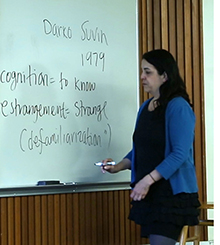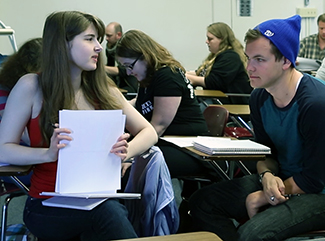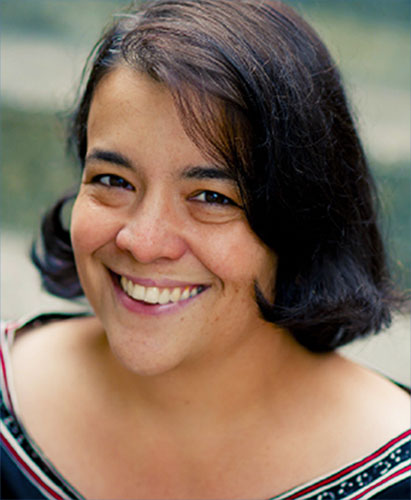INNOVATIVE TEACHING SHOWCASE
Exploring Differences through Writing and Literature
Introduction
The theme of this year's Innovative Teaching Showcase focuses on the always important topic of diversity in higher education. The topic theme for this year's Showcase, Infusing Multicultural Perspectives into the Curriculum, matters a great deal to me, both as an educator and a scholar, and I am honored that I was chosen to participate in this event. Teaching at Western has its rewards and challenges, among them being that I am surrounded by such talented, compassionate, and tireless colleagues who inspire me on a daily basis. I hope that what follows offers something of value to this exciting conversation.
My commitment to multiculturalism expresses itself in the courses I teach, the books I assign for those courses, and the classroom conversations both often invite. Here at Western, I teach and research twentieth and twenty-first century Chicana/o and African American literature. From large survey courses to intimate senior seminars, I get to introduce students (the majority of whom are white) to perspectives, experiences, and voices vastly different from their own. My Postmodern Blackness course, for example, introduces our English majors to writers like Ishmael Reed, Paul Beatty, and Colson Whitehead, all of whom epitomize the postmodern aesthetic, but do so from decidedly marginalized and racialized perspectives. Similarly my U.S. Multiethnic Literature Course ("Bodies in Motion") explores contemporary U.S. novels written by and largely about people of color, including not only African American and Chicana/o writers, but Asian American and Native American writers as well. These classes and others like them speak to my ongoing commitment to incorporating multicultural perspectives into my curriculum.
Writing through Differences
The scholarly work of literary studies is rigorous. In addition to encountering U.S. multiethnic literature on the page, my students must engage with their broader cultural, political, or even aesthetic concerns through analytical writing and, in more advanced courses, scholarly research. I find time and again that what often unites English majors at Western is their genuine love of language and its power to move, inspire, and transform. So, more often than not, they rise to the occasion of developing research projects, sorting and sifting through large chunks of information and ideas, and organizing them into a coherent, focused, and compelling argument.

I will not lie. Teaching multiracial U.S. literature at a predominantly white institution is challenging. This is because the topic of "race" remains a relatively difficult topic to discuss, even in the early twentieth century. Novels like Toni Morrison's Beloved and Helena Mara Viramontes's Their Dogs Came with Them are stunning works of art that are also decidedly political, especially when it comes to questions of race in the United States. Their innovative forms of narration invite provocative discussions of perspective, characterization, and representation, to be sure. But, because they confront the ugly realities of U.S. racism, both historically and in the present moment, they often appeal to students' emotional registers first. Classroom discussions can escalate quickly from a conversation about narrative voice to a more polarizing debate about white guilt or police brutality. These are not easy conversations to have, even if having them is in fact what the texts demand.
In my seventeen years of experience, I have found two persistent challenges in teaching what I do at a predominantly white school, even one as open-minded, tolerant, and committed to "diversity" as Western. First, most of literary works I teach center on characters whose lives have been indelibly shaped, for better and for worse, by the color of their skin. Yet, the majority of my students have never experienced racial subjectivity firsthand. That is, they have never experienced feeling "different" or marginal because of the color of the skin. Because of this, they often report being unable to identify with or relate to the texts they are being asked to read and think critically about. Of course, writers of color examine and imagine a wide range of experiences, many of which speak to the mere fact of being human, but race and the specter of this nation's violent racial history remain fundamental to a complete appreciation of their work.
Another persistent challenge is that students of color, because they are always in the minority at Western, often are the least inclined to speak up in class. I can relate to this entirely. As a woman of color and first generation college student, I never quite felt as though I belonged in the college classroom. Despite being surrounded by very liberal (and mainly white) professors and despite knowing that my peers (also mainly white) were themselves from liberal-minded homes and backgrounds, I regularly experienced being hyper self-conscious, especially in classes whose subject matters were decidedly about race. I remember one time vividly. We were discussing the work of Sandra Cisneros, a Mexican American (Chicana) writer. As the conversation began to unfold, it occurred to me that I had become what bell hooks calls the "native informant," the lone student of color in a classroom whose perspectives and interpretations are seen by the others as the most authentic and representative. This is a tremendously difficult responsibility to bear. Experience does not make one an expert.
To push back against these barriers, which they are if the end goal is to think analytically and critically about U.S. multiethnic literature, I strive to create a learning atmosphere that is both intellectually rigorous as well as safe. My pedagogical practices are deeply informed by the interplay of feminist, critical, and anticolonial modes of inquiry, so the former is not always the most difficult. Alongside this 'radical pedagogy' comes, as I see it, the responsibility of creating what bell hooks would call radically democratic classroom spaces. In keeping with these goals, I create assignments that allow students to express individual ideas in group settings that promote listening, civility, as well as inquiry and intellectual engagement.
Peer Review Workshop

One of my most successful of these assignments is the Peer Review Workshop. Inspired by my own experiences at academic conferences, where scholars come together to share works in progress, receive feedback from peers in their field, and learn about others work as well, I designed this assignment to create a space where students can share work that represents weeks of independent research, with other students endeavoring to do the same (and often working on the same texts). This assignment promotes both individual expression and collaborative thinking.
Literature as History
"This class seemed as much like a history class as a literature class. Comments like this are routine in my student evaluations. The reason for this is rather simple: I believe that literary texts also function as historical texts that offer insight into the communities they at once represent and imagine. I believe this to be particularly true for ethnic American writers whose collective histories often remain muted or, at worst, distorted by the Anglo-American cultural dominant. Writers like Toni Morrison and Sherman Alexie fictionalize history to reproduce it for the readers in often very intimate terms. Toni Morrison's Pulitzer-prize winning novel Beloved, for example, was immediately recognized for having portrayed slavery as it happened. Historicity is central to Chicano/a literary traditions as well. As Chicano literary scholar Ramon Saldvar has already observed, history cannot be conceived as the mere background or context of [Chicana/o] literature; rather, history turns out to be the decisive determinant of the form and content of the literature. In other words, Chicano/a literature also offers insight into the historical experiences of Mexican Americans.
For Chicano narrative, history is the subtext that we must recover because history itself is the subject of its discourse. History cannot be conceived as the mere "background" or "context" for this literature; rather, history turns out to be the decisive determinant of the form and content of the literature.
--Ramon Saldvar, Chicano Narrative
This idea of literature intersecting with history is readily explored in my Chicana/o Narrative courses, which I teach at all levels, from the lecture-heavy GUR to the discussion-oriented senior seminar. In one iteration of this class, for example, students read Tomas Rivera's Quinto Sol-award winning novel Y no se lo trago la tierra (And the Earth Did Not Devour Him), alongside Ernesto Galarza's autobiography Barrio Boy, both of which are migrant narratives that give voice to the voiceless and spotlight the hardships (and heart warming stories) of migrant families. Both published in 1971, these texts enact the spirit of the Chicano Movement (el movimiento), a brief yet electrifying period in Chicana/o history when art converged with activism. As historian George Mariscal has observed, el movimiento was a diffuse movement cross-cut by regional, gender, and class issues all united by a shared vision of elevating the material and political conditions of all Chicanas/os. My course explores how the literature produced during this time at once reflected, but also shaped the Movement.

One assignment that has really enabled students to think of texts contextually like this to understand how they both are produced by but also participate in a particular historical moment that exists as much within as it does outside of the text is my successful "Layered Questions" assignment, which asks students to interrogate a text from both within the text and beyond it.
The same link between the literary and the historical emerges in the African American literature courses I teach. In these classes, I aspire not merely to introduce my students to the major authors and periods of African American literary traditions. I also work hard to help them draw connections between the earliest forms of African American cultural expressions and contemporary reiterations of said expressions, bridging historical periods and the literature each period produced. For example, students trace the ways in which slavery gave rise to the slave song, a vernacular form of cultural expression that comes not from outside the black community, but from within. Later in the quarter, when we get to spoken word poetry and hip-hop, students are then asked to identify thematic, even aesthetic parallels between these more contemporary forms of expression and their literary antecedents.
Project Mash-Up

One of my most successful assignments to bring this link to life is what I call Project Mash-Up, a multimedia creative assignment that asks students to create a digital collage that reflects their interpretation of a key theme, concept, or idea from our course reading material. It is almost always the case that students, in responding to this assignment, demonstrate their understanding of how literary texts are situated within historical contexts that both exist beyond, but also deeply inform, the texts. What makes the Mash-Up unique and far more engaging to many students than, say, the traditional essay, is that it invites students to draw from the space they perhaps know best cyberspace to demonstrate learning and to express individual ideas about what they've learned.
Moreover, because the mash-up requires that students juxtapose texts of all media photographs, visual art, literary texts, criticism, and personal claims they must engage the literature from multiple perspectives (which is, really, essential to understanding and appreciating multiculturalism). One particular student, (see Student Example of Mash-up) explores how racial subjectivity has manifested in both African American and Chicana/o cultural histories in ways both very different and expectedly similar, thus commenting on the multifaceted nature of race (and racism) in the United States.
Everything I teach at Western centers as much on the discipline of literary studies and the production of scholarly research as well as issues related to race and ethnicity in the United States since 1865 to the present (see Overview of Courses).
Conclusion

Looking forward, I see myself inventing new courses that ultimately engage a more intersectional approach to the study of American ethnic literatures, which I believe to be essential to cultivating an appreciation for the ways in which American ethnic literatures function both on their own terms and within the broader contexts of race and ethnicity in the twenty-first century United States. During a time when developments in globalization and new communication technologies have radically reshaped what constitutes otherness, ethnicity, and the logics of the nation state, a more intersectional, hybrid, and even flexible understanding of cultural identity in the United States is essential to rendering the literature both relevant and meaningful to today's twenty-first century college student. Indeed, as Donald E. Pease notes in one of the monographs I read this summer: Transnational perspectives have changed the way Americanist scholars imagine their relationship to their work, their objects of study, and their disciplinary protocols (Reframing the Transnational Turn).
↑ Go to top



